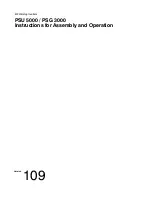
SECTION 3 - CHASSIS & TURNTABLE
3121234
3-201
Table 3-13. Symptom Diagnosis
Checks
Action
Important Preliminary Checks
Before Using This Section
Before using this section, you should have performed On Board Diagnostic Check and determined that:
1. The Control Module and MIL (Malfunction Indicator Lamp) are operating correctly.
2. There are no Diagnostic Trouble Codes (DTCs) stored, or a DTC exists but without a MIL.
Several of the following symptom procedures call for a careful visual and physical check. The visual and physical checks are very important. The
checks can lead to correcting a problem without further checks that may save valuable time.
LPG Fuel System Check
1. Verify the customer complaint.
2. Locate the correct symptom table.
3. Check the items indicated under that symptom.
4. Operate the vehicle under the conditions the symptom occurs. Verify HEGO switching between lean and rich.
IMPORTANT! Normal HEGO switching indicates the LPG fuel system is in closed loop and operating correctly at that time.
Visual and Physical Checks
Check all ECM system fuses and circuit breakers.
Check the ECM ground for being clean, tight and in its proper location.
Check the vacuum hoses for splits, kinks and proper connections.
Check thoroughly for any type of leak or restriction.
Check for air leaks at all the mounting areas of the intake manifold sealing surfaces.
Check for proper installation of the mixer module assembly.
Check for air leaks at the mixer assembly.
Check the ignition wires for the following conditions:
- Cracking
- Hardness
- Proper routing
- Carbon tracking
Check the wiring for the following items:
- Proper connections, pinches or cuts.
The following symptom tables contain groups of possible causes for each symptom. The order of these procedures is not important. If the scan
tool readings do not indicate the problems, then proceed in a logical order, easiest to check or most likely to cause first.
Intermittent
DEFINITION: The problem may or may not turn ON the Malfunction Indicator Lamp (MIL) or store a Diagnostic Trouble Code (DTC).
Preliminary Checks
Refer to Important Preliminary Checks.
Do not use the DTC tables. If a fault is an intermittent, the use of the DTC tables may result in the replacement of good parts.
Faulty Electrical Connections or Wiring
Faulty electrical connections or wiring can cause most intermittent problems.
Check the suspected circuit for the following conditions:
- Faulty fuse or circuit breaker
- Connectors poorly mated
- Terminals not fully seated in the connector (backed out)
- Terminals not properly formed or damaged
- Terminal to wires poorly connected
- Terminal tension insufficient
Carefully remove all the connector terminals in the problem circuit in order to ensure the proper contact tension. If necessary, replace all the
connector terminals in the problem circuit in order to ensure the proper contact tension.
Checking for poor terminal to wire connections requires removing the terminal from the connector body.
Operational Test
If a visual and physical check does not locate the cause of the problem, drive the vehicle with a scan tool. When the problem occurs, an abnormal
voltage or scan reading indicates the problem may be in that circuit.
Summary of Contents for 680S
Page 2: ......
Page 52: ...SECTION 2 GENERAL 2 14 3121234 NOTES...
Page 55: ...SECTION 3 CHASSIS TURNTABLE 3121234 3 3 This page left blank intentionally...
Page 89: ...SECTION 3 CHASSIS TURNTABLE 3121234 3 37 Figure 3 28 Assembly Tools Seal Pressing...
Page 139: ...SECTION 3 CHASSIS TURNTABLE 3121234 3 87 Figure 3 62 Swing Hub Prior to SN 0300134352...
Page 143: ...SECTION 3 CHASSIS TURNTABLE 3121234 3 91 Figure 3 64 Swing Brake...
Page 205: ...SECTION 3 CHASSIS TURNTABLE 3121234 3 153 This page left blank intentionally...
Page 208: ...SECTION 3 CHASSIS TURNTABLE 3 156 3121234 Figure 3 91 Generator Electrical Circuit Diagram...
Page 224: ...SECTION 3 CHASSIS TURNTABLE 3 172 3121234 Figure 3 103 EMR 2 Engine Side Equipment...
Page 225: ...SECTION 3 CHASSIS TURNTABLE 3121234 3 173 Figure 3 104 Deutz EMR 2 Troubleshooting Flow Chart...
Page 229: ...SECTION 3 CHASSIS TURNTABLE 3121234 3 177 Figure 3 108 EMR 2 Engine Plug Pin Identification...
Page 230: ...SECTION 3 CHASSIS TURNTABLE 3 178 3121234 Figure 3 109 EMR 2 Vehicle Plug Pin Identification...
Page 231: ...SECTION 3 CHASSIS TURNTABLE 3121234 3 179 Figure 3 110 EMR2 Fault Codes Sheet 1 of 5...
Page 232: ...SECTION 3 CHASSIS TURNTABLE 3 180 3121234 Figure 3 111 EMR2 Fault Codes Sheet 2 of 5...
Page 233: ...SECTION 3 CHASSIS TURNTABLE 3121234 3 181 Figure 3 112 EMR2 Fault Codes Sheet 3 of 5...
Page 234: ...SECTION 3 CHASSIS TURNTABLE 3 182 3121234 Figure 3 113 EMR2 Fault Codes Sheet 4 of 5...
Page 235: ...SECTION 3 CHASSIS TURNTABLE 3121234 3 183 Figure 3 114 EMR2 Fault Codes Sheet 5 of 5...
Page 264: ...SECTION 3 CHASSIS TURNTABLE 3 212 3121234 NOTES...
Page 285: ...SECTION 4 BOOM PLATFORM 3121234 4 21 This page left blank intentionally...
Page 333: ...SECTION 4 BOOM PLATFORM 3121234 4 69 Figure 4 25 Load Sensing Device...
Page 336: ...SECTION 4 BOOM PLATFORM 4 72 3121234 NOTES...
Page 416: ...SECTION 5 BASIC HYDRAULICS INFORMATION SCHEMATICS 5 80 3121234 NOTES...
Page 423: ...SECTION 6 JLG CONTROL SYSTEM 3121234 6 7 Figure 6 2 ADE Block Diagram...
Page 480: ...SECTION 6 JLG CONTROL SYSTEM 6 64 3121234 NOTES...
Page 528: ...SECTION 7 BASIC ELECTRICAL INFORMATION SCHEMATICS 7 48 3121234 NOTES...
Page 529: ......
















































